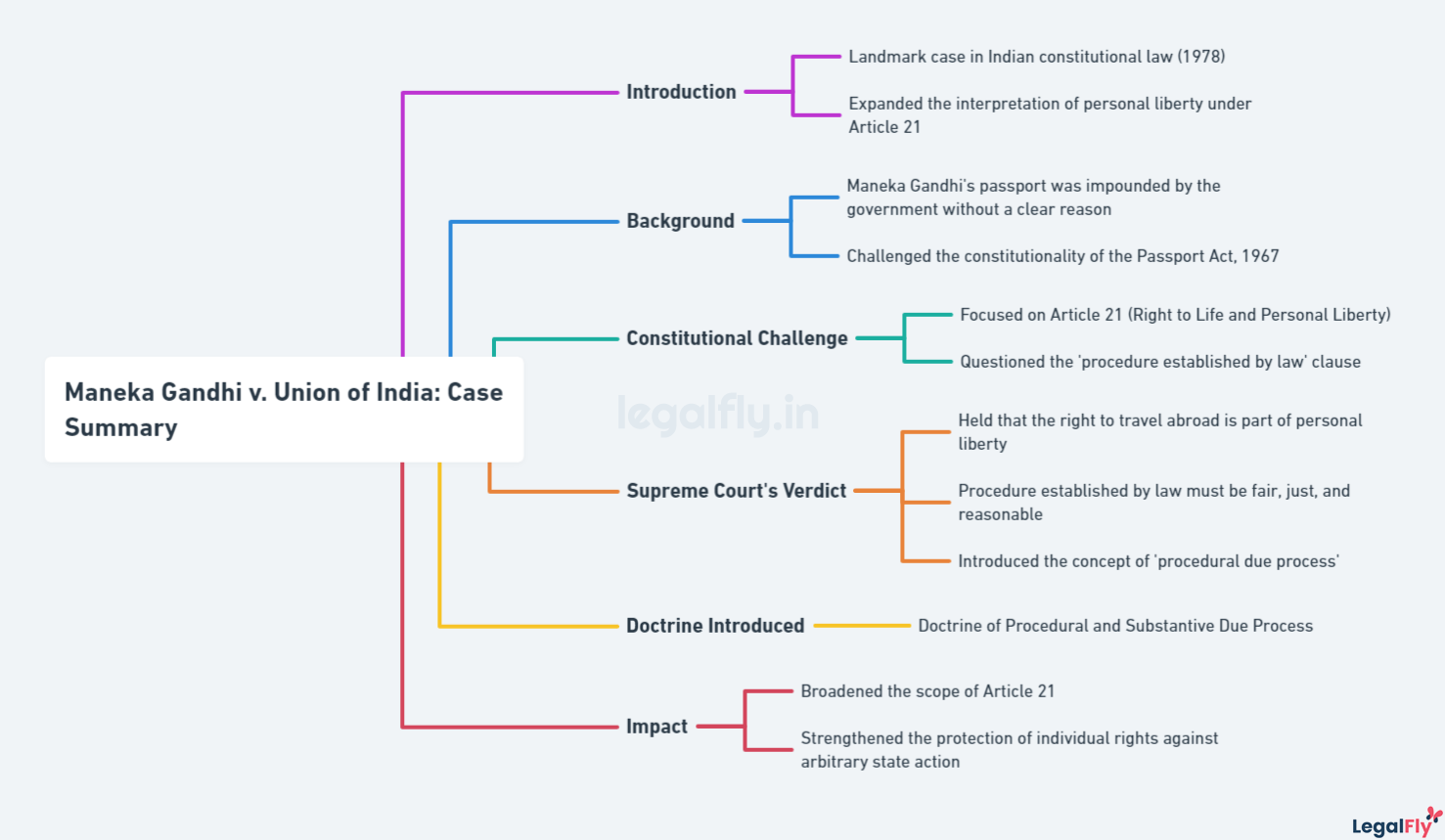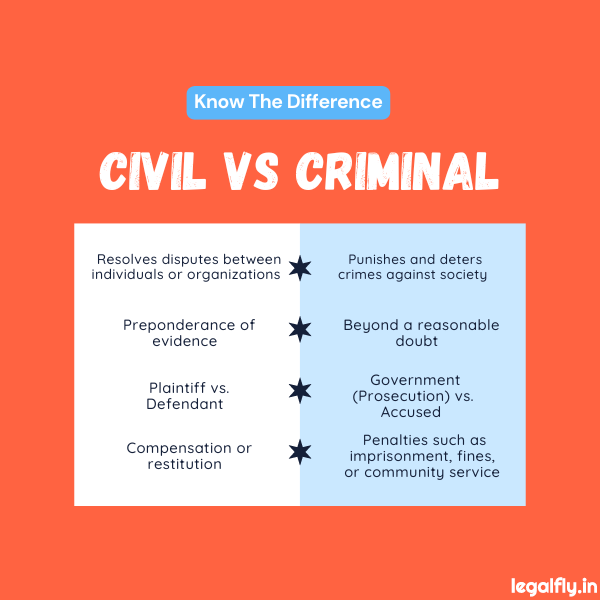Case Name: Maneka Gandhi vs Union Of India
Court: Supreme Court of India
Year: 1978
Citation: 1978 AIR 597, 1978 SCR (2) 621, 1978 SCC (1) 248
Table of Contents
Introduction to Maneka Gandhi v. Union of India
Maneka Gandhi v. Union of India is a landmark case in Indian constitutional law decided by the Supreme Court of India in 1978. The case arose when Maneka Gandhi, an Indian activist and politician, had her passport impounded by the Government of India in 1977 “in public interest” without providing any reasons. When Maneka Gandhi challenged this action in the Supreme Court, several important legal issues came up for consideration.
The key legal issues challenged in this case were:
- The fundamental right to travel abroad under Article 21 of the Indian Constitution.
- The interrelationship between fundamental rights described in Articles 14, 19 and 21.
- The concept of ‘procedure established by law’ under Article 21.
- The limitations on the government’s power to restrict personal liberties.
- The need for following principles of natural justice and procedural fairness.

This case resulted in a landmark judgment by the Supreme Court that expanded the scope of Article 21 and strengthened civil liberties in India. The judgment established important constitutional principles and had a far-reaching impact on Indian jurisprudence.
The Supreme Court’s Groundbreaking Judgment
The Supreme Court’s judgment in Maneka Gandhi v. Union of India significantly expanded the scope of Article 21 of the Constitution, which guarantees the right to life and personal liberty. Before this case, Article 21 was narrowly interpreted to mean only the protection of life and personal liberty against executive action that contravenes established legal procedures.
However, the Supreme Court ruled that the right to life and personal liberty under Article 21 encompasses not only physical integrity but also all those liberties and freedoms that make up a person’s personal liberty. Thus, Article 21 also comprises a variety of rights, including the right to travel, the right to privacy, the right against solitary confinement, and the right against handcuffing, among others.
The Court also established that any law laying down a procedure for depriving a person of their personal liberty has to be “right, just and fair” and not “arbitrary, fanciful or oppressive.” This introduced the concept of reasonableness and fairness as essential criteria for judging the validity of laws imposing restrictions on personal freedom under Article 21. The ruling significantly strengthened the constitutional protection of life and personal liberty in India.
The Golden Triangle: Articles 14, 19, and 21
The term “Golden Triangle” refers to the interrelationship and interdependence between Articles 14, 19 and 21 of the Indian Constitution. These articles contain the fundamental rights to equality, freedom of speech and expression, and life and personal liberty, respectively.
The rights enshrined in these three articles are complementary and closely connected. Article 14 ensures equality before the law and equal protection under the law. This forms the basis for enjoying the various freedoms under Article 19. At the same time, the right to life and personal liberty under Article 21 depends on the protections afforded by Articles 14 and 19. Any violation of rights under Articles 14 and 19 could also potentially violate Article 21.

The Supreme Court firmly established the interrelationship between these articles in the Maneka Gandhi v. Union of India case. The judgment made it clear that these articles together form an integrated scheme for protecting fundamental rights. This has significant implications for how fundamental rights are interpreted in the future. Any restrictions on the rights under Article 19 must also meet the broader test of not violating Articles 14 and 21. This expanded approach ensures greater protection of civil liberties and limits the scope for arbitrary state action.
The Maneka Gandhi judgment also opened up the possibility of reading new rights into Article 21 based on their relationship with rights under Articles 14 and 19. Later cases expanded Article 21 to include rights such as privacy and dignity based on this interconnection. Therefore, the Golden Triangle has strengthened constitutional safeguards for individual freedom and paved the way for evolving interpretations of fundamental rights in India.
Analysis of the Court’s Ruling
The Supreme Court’s ruling in Maneka Gandhi v. Union of India significantly expanded the interpretation of Article 21 and the right to personal liberty. The Court held that the right to travel abroad was part of the right to personal liberty under Article 21. This departed from previous rulings that had narrowly construed Article 21 to only protect against the deprivation of life and personal liberty in accordance with procedure established by law.
The Court also emphasized the importance of procedural fairness and principles of natural justice in any procedure that restricted personal liberty under Article 21. This established that arbitrary executive actions infringing on personal freedom would need to be tested against these principles. The government could not simply claim that proper procedure was followed without demonstrating reasonableness, fairness, and good faith.
Impact on Indian Jurisprudence with Other Case Studies
The Maneka Gandhi case profoundly impacted Indian jurisprudence by strengthening the doctrine of due process and influencing subsequent legal cases and policies.
The judgment established that any procedure restricting personal liberty must be fair, just, and reasonable. This principle of due process became an integral part of Article 21 interpretation and placed procedural fairness at the heart of Indian constitutional law.
The Maneka Gandhi precedent set strict scrutiny for any law that infringed on fundamental rights. This led to the striking down of arbitrary preventive detention laws and the affirmation of personal liberty protections (Impact of Maneka Gandhi Case on Criminal Justice Administration in India).
The principles established in this case paved the way for an expansive interpretation of Article 21. Several cases have cited its principles, emphasizing the expansion of fundamental rights and procedural due process. Here are some key cases collated by LegalFly team based on our research:
- Olga Tellis v. Bombay Municipal Corporation (1985): This case confirmed the right to livelihood under the right to life, expanding Article 21’s scope.
- Mohini Jain v. State of Karnataka (1992): Recognized the right to education as intrinsic to the right to life in Article 21.
- Rajagopal v. State of Tamil Nadu (1994): Extended the right to life to include the right to privacy and dignity.
- People’s Union for Civil Liberties (PUCL) v. Union of India (1997): Emphasized the importance of procedural fairness and transparency in phone tapping, underlining the right to privacy as part of Article 21.
- Navtej Singh Johar v. Union of India (2018): Decriminalized homosexuality, with the court recognizing the importance of dignity, autonomy, and privacy as part of the right to life under Article 21.
- Hussainara Khatoon v. State of Bihar (1979): This case highlighted the right to a speedy trial as an essential part of Article 21, emphasizing that the right to life includes the right to live with human dignity and not just mere animal existence. It brought attention to the plight of undertrial prisoners, leading to the release of over 40,000 undertrial prisoners.
- Sunil Batra v. Delhi Administration (1978): The case extended the application of Article 21 to include the treatment of prisoners, asserting that the fundamental right to life and liberty was also applicable to prison inmates. It marked a significant step towards prison reform in India, advocating against inhumane treatment and torture in prisons.
Overall, the Maneka Gandhi v. Union of India judgment transformed Indian constitutional law by prioritizing civil liberties and affirming that restrictions on personal freedom must be procedurally reasonable, fair, and just. Its influence strengthened judicial review and individual rights against arbitrary state action.
Critical Perspectives on the Judgment
Legal scholars and commentators have extensively analyzed and critiqued the judgment in Maneka Gandhi v. Union of India. While many have praised the landmark ruling, some have also raised important critical perspectives.
Legal Scholarship and Commentary
Several legal experts have provided detailed commentary on the implications of the Maneka Gandhi judgment. Some scholars, like Upendra Baxi, have called it a “magna carta of liberty” that fundamentally altered the scope of Article 21. Others have analyzed how it expanded judicial review powers and the interpretation of fundamental rights. The judgment has been extensively examined from both a constitutional law perspective and a human rights lens.
Debates and Criticisms of the Ruling
However, the Maneka Gandhi v. Union of India case has also been criticized and debated. Some argue it granted the judiciary too much unrestrained power to review laws restricting personal liberty. The lack of clear guidelines on “procedure established by law” has also been highlighted as a potential downside. While recognizing its positive impact, legal experts continue to evaluate the Maneka Gandhi judgment and its legacy critically.
The Legacy of Maneka Gandhi v. Union of India
Maneka Gandhi v. Union of India has had a lasting impact on civil liberties and constitutional law in India. The judgment significantly expanded the scope of Article 21 and established due process principles as an integral part of Indian jurisprudence.
The case continues to be relevant in contemporary legal discussions on personal freedom and limits on state power. Scholars have noted that Maneka Gandhi’s principles are frequently cited in cases relating to preventive detention, prisons, and mental health. The judgment also reinforced the interconnection between Articles 14, 19, and 21, a foundation for interpreting fundamental rights.
Several subsequent cases have followed the precedent set by Maneka Gandhi in expanding civil liberties. These include cases related to speedy trials, prisoner rights, privacy, and reproductive autonomy, among others. Maneka Gandhi’s principles continue to empower citizens to challenge unreasonable restrictions on their freedom before the courts.
Overall, Maneka Gandhi’s legacy is a landmark in India’s constitutional history. The case significantly enhanced civil liberties and individual freedoms by strengthening due process and narrowing the scope of arbitrary state action.
Conclusion: Significance of Maneka Gandhi v. Union of India
Maneka Gandhi v. Union of India is considered one of the most significant cases in Indian constitutional law history. The 1978 Supreme Court judgment shaped modern interpretations of fundamental rights and constitutional protections.
The case marked a defining moment by expanding the scope of Article 21 and establishing the interconnection between essential civil liberties. By ruling that the right to life and personal liberty could not be deprived arbitrarily, the Court enhanced safeguards for individual freedoms.
The judgment established a broad understanding of the “right to life,” encompassing various human rights. This departed from previous narrow views that focused only on literal survival. The Court asserted that the spirit of the Constitution required the right to life to be interpreted expansively.
Additionally, the ruling affirmed that fundamental rights must be read together. Restricting an individual’s movement was seen to violate not just Article 21 but also Articles 14 and 19. This integrated approach was critical to developing the “golden triangle” doctrine of interpreting fundamental rights.
Maneka Gandhi’s case secured vital procedural due process protections by underscoring the principles of natural justice and fairness. The precedent required reasonable restrictions on freedom and established proper guidelines.
The monumental shift initiated by this case significantly strengthened civil liberties and individual rights under the Constitution. Its legacy continues to influence modern Indian jurisprudence and governance. The judgment remains a hallmark of the Supreme Court’s profound impact in advancing constitutional values and safeguards.




